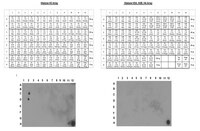07-450-S Sigma-AldrichAnti-monomethyl-Histone H3 (Lys9) Antibody, Trial Size
Anti-monomethyl-Histone H3 (Lys9) Antibody, Trial Size is a purified rabbit polyclonal that detects Histone H3 monomethylated on lysine 9 (H3K9me1). This Ab is specificity verified by dot blot (DB), and validated in ICC, PIA, WB. The small pack size is ideal for screening applications.
More>> Anti-monomethyl-Histone H3 (Lys9) Antibody, Trial Size is a purified rabbit polyclonal that detects Histone H3 monomethylated on lysine 9 (H3K9me1). This Ab is specificity verified by dot blot (DB), and validated in ICC, PIA, WB. The small pack size is ideal for screening applications. Less<<Recommended Products
Áttekintés
| Replacement Information |
|---|
Kulcsspecifikációk táblázata
| Species Reactivity | Key Applications | Host | Format | Antibody Type |
|---|---|---|---|---|
| H, M, Ch | DB, ICC, PIA, WB | Rb | Purified | Polyclonal Antibody |
| References |
|---|
| Product Information | |
|---|---|
| Format | Purified |
| Control |
|
| Presentation | Purified rabbit IgG in buffer containing 0.1 M Tris-glycine, pH 7.4, 0.105 M NaCl, 0.035% sodium azide and 30% glycerol. |
| Quality Level | MQ100 |
| Physicochemical Information |
|---|
| Dimensions |
|---|
| Materials Information |
|---|
| Toxicological Information |
|---|
| Safety Information according to GHS |
|---|
| Safety Information |
|---|
| Packaging Information | |
|---|---|
| Material Size | 10 µg |
| Transport Information |
|---|
| Supplemental Information |
|---|
| Specifications |
|---|
| Global Trade Item Number | |
|---|---|
| Katalógusszám | GTIN |
| 07-450-S | 04053252919138 |
Documentation
Anti-monomethyl-Histone H3 (Lys9) Antibody, Trial Size MSDS
| Title |
|---|









